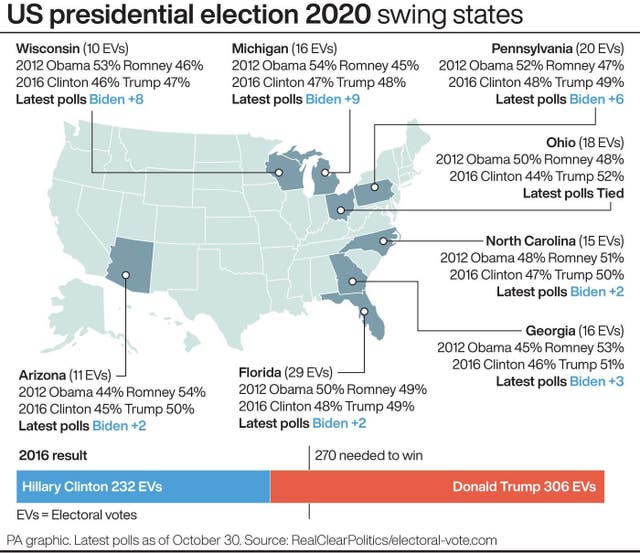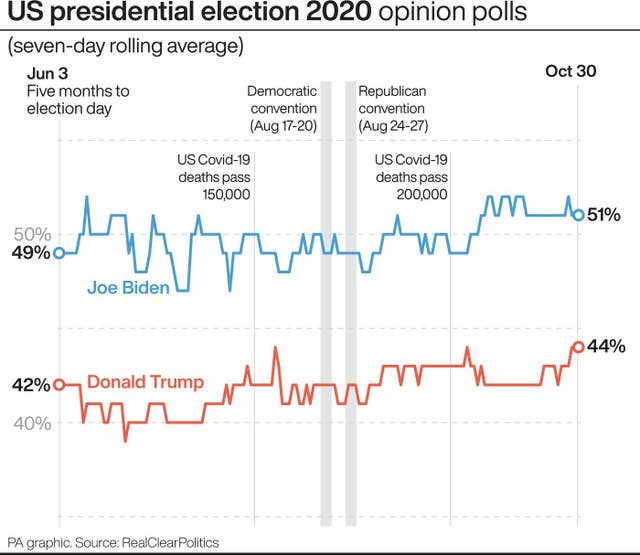A handful of states will play a crucial role in determining the outcome of the 2020 United States presidential election.
These are the “swing states”: so called because they will help swing the overall result either way. Most states are not swing states and will not change hands at this election – but safe states alone are not enough to get either Trump or Biden to the White House.
Here are eight swing states to watch. All were won by Trump in 2016, but all are being strongly contested at this election by Biden.

– Florida
This is the most hotly-contested swing state of them all. Florida has been a nailbiter in almost every presidential election since 1992, most famously in 2000 when George W Bush won the state by just 537 votes out of a total of six million cast.
Support for both Republican and Democrats is finely balanced, with just one percentage point separating Barack Obama from Mitt Romney in 2012, and Trump from Hillary Clinton in 2016.
Both of this year’s candidates will be desperate to pick up Florida’s 29 electoral votes – the biggest number for any of the swing states – though the arithmetic is probably on Biden’s side. He has a number of ways to reach the 270 winning post, with or without Florida, while for Trump this is pretty much a must-win state.
– Pennsylvania
Trump turned Pennsylvania into a swing state in 2016, confounding those who assumed this was a Democratic stronghold, as had been the case since Bill Clinton won the state in 1992.
With 20 electoral votes up for grabs, this is key target for both Trump and Biden. It’s Biden’s home state – he was born in the city of Scranton – and he has enjoyed a small but steady lead in Pennsylvania’s polls for several months. In 2016, Trump’s margin of victory over Clinton was just 0.7% of the vote.

– Michigan
Like Pennsylvania, this was part of the “blue wall” of states that voted Democrat at every presidential election from 1992 to 2012.
Trump’s victory in 2016 was tiny – by just 0.2% of the vote – but symbolised the scale of his success in wooing working-class voters away from Clinton, particularly in a state that Obama had carried by nine percentage points in 2012.
There are 16 electoral votes in play here. Polls have put Biden consistently ahead of Trump for the past few months.
– Wisconsin
Another “blue wall” state that Trump won narrowly in 2016. As is the case with Pennsylvania and Michigan, the result in Wisconsin might not be clear for several days, thanks to the volume of postal and early votes that will need to be sorted and counted.
This could mean that the overall winner of the election is not known for some time – though both candidates might try and mount legal challenges to pause, extend, or even halt the counting. Ten electoral votes are available here.

– Ohio
Since 1964, whoever has won Ohio has gone on to become president – the longest uninterrupted streak of any of the “bellwether” states.
In 2016, Trump enjoyed a comfortable victory over Clinton by eight percentage points. In 2020 the polls suggest the race is too close to call.
It is another state with a sizeable chunk of electoral votes up for grabs – 18 – but as with Florida, a win here is probably more crucial for Trump than Biden in terms of making it to the winning post.
– Arizona
The reason Biden has more paths to the White House than Trump is thanks to states like Arizona.
No Democrat has won Arizona since Bill Clinton in 1996, and in 2016 Trump beat Hillary Clinton here by five percentage points.
But this year, Biden has turned it into a swing state, reflected in a run of opinion polls that have put him either ahead of or level with Trump.
Arizona does not offer as many electoral votes as other swing states – 11 – but they could be vital for Biden’s chances were he to lose in places like Florida.
– North Carolina
This is another state in play this year thanks to a strong showing by Biden. Obama won North Carolina in 2008 – the first Democrat to do so since Jimmy Carter in 1976.
Obama lost the state in 2012, however, as did Hillary Clinton in 2016. This year polls suggest Biden could nudge the state and its 15 electoral votes back into the Democratic column, though the result – as at recent elections – could be very close.
North Carolina and Florida are the two swing states most likely to report prompt results on election night, and as such will give an early indication of how both Biden and Trump are faring.
– Georgia
No Democrat has won Georgia since Clinton in 1992. Obama never came close, and Trump won it by a comfortable six percentage points in 2016.
Yet in 2020 Georgia, with its 16 electoral votes, has become the most unexpected swing state of them all. Biden has steadily closed the gap on Trump in the polls, eventually drawing level and occasionally pulling ahead.
Wins for Biden in places like Georgia and North Carolina would knock out states that are vital for Trump’s re-election.
But remember opinion polls are only snapshots, not predictions, and ultimately the outcome in places like Georgia may come down to which side manages to get more of its supporters to turn out and vote.


















